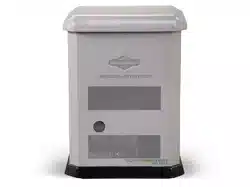Loading ...
Loading ...
Loading ...

1
• (A)Front side of enclosure
• (B, D, F, J and K)Neutral air exchange ducts
• (C)Exhaust outlet
• (E)Engine intake duct
• (G) Back side of enclosure
• (H) Alternator inlet duct
Generator Location Considerations
The installation location of the generator directly effects:
1. The amount and size of the plumbing required to fuel the
generator.
2. The amount and size of the wiring required to control and
connect the generator.
3. The safety of the installation regarding exhaust gas and
carbon monoxide hazards, fire risks, proximity to other
utilities, and exposure to weather elements.
The Generator Placement section addresses specific location
guidelines. The owner and installer must speak to one
another to determine how the site can affect installation costs
and compliance with local codes and standards.
Federal and International Standards
Generator installation must strictly adhere to ICC, IFGC,
NFPA 37, NFPA 54, NFPA 58, and NFPA 70 standards.
National Fire Protection Association (NFPA) 37: This
standard addresses the installation and use of stationary
combustion engines. Its requirements describe keeping
an enclosed generator a specific distance from a structure
or wall. This standard also requires that when you locate
a generator, you provide adequate space to perform
maintenance and repair tasks and space for the maneuvering
of first responders.
NFPA 37, Section 4.1.4, Engines Located Outdoors: This
requirement specifies that engines and their weatherproof
housings (if provided) installed outdoors must remain at least
5 ft (1.52 m) from openings in walls and at least 5 ft (1.52 m)
from structures with combustible walls. The standard does
not require a minimum separation if either of the following
conditions exist:
1. The structure’s adjacent wall has a fire-resistance rating
of at least one hour.
2. Where a fire test involving consumption of the available
combustibles, within the engine or, if provided, its
weatherproof housing demonstrates that a fire originating
at the engine or its weatherproof housing will not ignite
combustible structures.
Annex A—Explanatory Material
A4.1.4 (2): This requirement means that demonstrating
compliance involves conducting a full-scale fire test or by
followingthe calculation procedures found in Chapter 10 of
NFPA 555.
This requirement concludes that due to the limited space
frequently available for installation of the unit, exception (2) is
beneficial for many residential and commercial installations.
The manufacturer has contracted with an independent testing
laboratory to conduct full-scale fire tests.
The ultimate goal of the fire testing was to evaluate the
absolute worst fire scenario within the generator andto
determine the ignition risk foritems outside the engine
enclosure at specific distances. Note that the enclosure is
constructed of non-combustible materials. Outcomes from
independent lab tests showed that a fire that started within
the generator enclosure would not pose an ignitability risk to
nearby combustibles or structures for at least one hour.
Combining results from these full-scale tests and the
requirements of NFPA 37, Sec 4.1.4, the guidelines for
installation of the generators previously mentioned change
to 18 in (45.7 cm) from the back side of the generator to a
stationary wall or building.For more information see Distance
Requirements section in this manual.
Reduce the Risk of Carbon Monoxide Poisoning
In high concentrations, carbon monoxide (CO) can be fatal
in minutes. However, the effects of lower concentrations can
also be lethal. This gas poses serious dangers to humans
7
Not for
Reproduction
Loading ...
Loading ...
Loading ...
